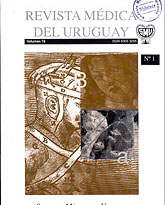Dermatoscopy in melanocytic lesions
Critical cutting-points of total dermatoscopic score for diagnosing melanoma
Abstract
Dermatoscopy has proved its diagnostic capacity in early stages of melanoma.
Total dermatoscopic score (TDS) is one of the most used quantification risk system.
Strategy of validation involved its application to a wide group of melanocytic lesions, including melanomas of easy diagnosis with high TDS, thus, cutting-points were of high exigency. This might have caused decrease in predictive value of negative tests (VPNN) in clinically 'suspicious' lesions (LCD) among fine melanocytic nevi with intense junction activity. The study aimed at analyzing TDS cutting-points applicable to LCD that could reduce proportion of false negative tests.
Method. Out of 2 396 melanocytic lesions, 187 were dried and studied. More than 50% was integrated by congenital or acquired melanocytic nevi, lentigos actinics and clinically evident melanomas while 92 fitted LCD melanoma, determined the study group. TDS was calculated for each LCD melanoma, following classic criteria. Diagnosis was determined for all cases by pathologic anatomy (AP), two groups were studied according to sex, age, phototype, and familial syndrome of multiple nevi and atypical nevos, or both (SNM and SNA).
Results. PA showed 63 melanocytic nevi (group A) and 29 melanomas (group B). No differences in relation to sex, age, phototype, SNM or SNA were found. Exactitude parameters were calculated using TDS values; a ROC curve helped to determine suitable cutting-points, in this study it was lower than Stolz', showing 93.1% sensibility, 85.7% specificity and 96.4% VPPN.
Discussion. Our findings showed that the proposed cutting-point achieved an excellent VPPN with no alterations at sensibility and specificity levels. More numerous and prospective studies are needed to validate this proposition.
References
2) Carli P, De Giorgi V, Palli D, Maurichi A, Mulas P, Orlandi C, et al. Dermatologist detection and skin self-examination are associated with thinner melanomas: results from a survey of the Italian Multidisciplinary Group on Melanoma. Arch Dermatol 2003; 139(5): 607-12.
3) Veronesi A, Pizzichetta MA, De Giacomi C, Gatti A, Trevisan G. Regional Committee for the Early Diagnosis of Cutaneous Melanoma. A two-year regional program for the early detection of cutaneous melanoma. Tumori 2003; 89(1): 1-5.
4) Blum A, Rassner G, Garbe C. Modified ABC-point list of dermoscopy: A simplified and highly achúrate dermoscopic algorithm for the diagnosis of cutaneous melanocytic lesions. J Am Acad Dermatol 2003; 48(5):672-8.
5) Binder M, Schwarz M, Winkler A, Steiner A, Kaider A, Wolff K, et al. Epiluminescence microscopy. A useful tool for the diagnosis of pigmented skin lesions for formally trained dermatologists. Arch Dermatol 1995; 131(3): 286-91.
6) Carli P, Mannone F, De Giorgi V, Nardini P, Chiarugi A, Giannotti B. The problem of false-positive diagnosis in melanoma screening: the impact of dermoscopy. Melanoma Res 2003; 13(2): 179-82.
7) Grin CM, Friedman KP, Grant-Kels JM. Dermoscopy: a review. Dermatol Clin 2002; 20(4): 641-6, viii.
8) Nehal KS, Oliveria SA, Marghoob AA, Christos PJ, Dusza SW, Tromberg JS, et al. Use of and beliefs about dermoscopy in the management of patients with pigmented lesions: a survey of dermatology residency programmes in the United States. Melanoma Res 2002; 12(6): 601-5.
9) Mackie RM. An aid to the preoperative assessment of pigmented lesions of the skin. Br J Dermatol 1971; 85(3): 232-7.
10) Ascierto PA, Palmieri G, Botti G, Satriano RA, Stanganelli I, Bono R, et al. Early diagnosis of malignant melanoma: proposal of a working formulation for the management of cutaneous pigmented lesions from the Melanoma Cooperative Group. Int J Oncol 2003; 22(6): 1209-15.
11) Nachbar F, Stolz W, Merkle T, Cognetta AB, Vogt T, Landthaler M, et al. The ABCD rule of dermatoscopy: high prospective value in the diagnosis of doubtful melanocytic skin lesions. J Am Acad Dermatol 1994; 30(4): 551-8.
12) Stolz W, Braun-Falco O, Bilek P, Landthaler M, Cognetta AB. Color Atlas of Dermatoscopy. Cambridge: Blackwell, 1994.
13) Bafounta ML, Beauchet A, Aegerter P, Saiag P. Is dermoscopy (epiluminescence microscopy) useful for the diagnosis of melanoma? Results of a meta-analysis using techniques adapted to the evaluation of diagnostic tests. Arch Dermatol 2001; 137(10): 1343-50.
14) Kittler H, Pehamberger H, Wolff K, Binder M. Diagnostic accuracy of dermoscopy. Lancet Oncology 2002; 3(3): 159-65.
15) Cristofolini M, Zumiani G, Bauer P, Cristofolini P, Boi S, Micciolo R. Dermatoscopy: usefulness in the differential diagnosis of cutaneous pigmentary lesions. Melanoma Res 1994; 4(6): 391-4.
16) Lorentzen H, Weismann K, Kenet RO, Secher L, Larsen FG. Comparison of dermatoscopic ABCD rule and risk stratification in the diagnosis of malignant melanoma. Acta Derm Venereol 2000; 80(2): 122-6.
17) Argenziano G, Soyer HP, Chimenti S, Talamini R, Corona R, Sera F, et al. Dermoscopy of pigmented skin lesions: results of a consensus meeting via the Internet. J Am Acad Dermatol 2003; 48(5): 679-93.
18) Carli P, De Giorgi V, Chiarugi A, Nardini P, Mannone F, Stante M, et al. Effect of lesion size on the diagnostic performance of dermoscopy in melanoma detection. Dermatology 2003; 206(4):292-6
19) Schiffner R, Wilde O, Schiffner-Rohe J, Stolz W. Difference between real and perceived power of dermoscopical methods for detection of malignant melanoma. Eur J Dermatol 2003; 13(3): 288-93.

This work is licensed under a Creative Commons Attribution-NonCommercial 4.0 International License.













